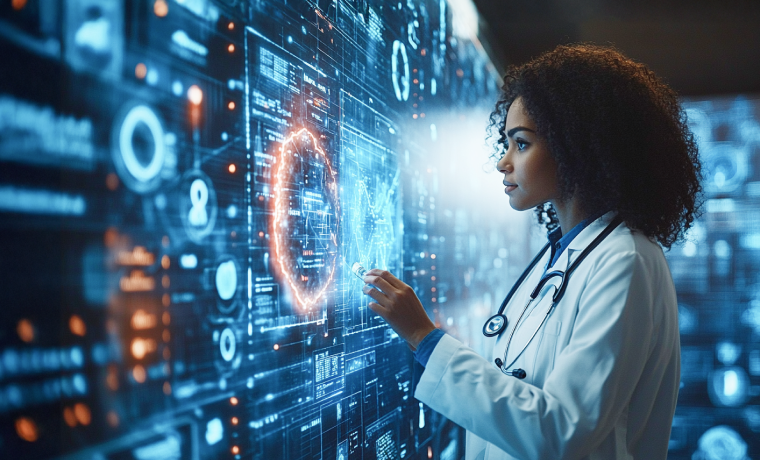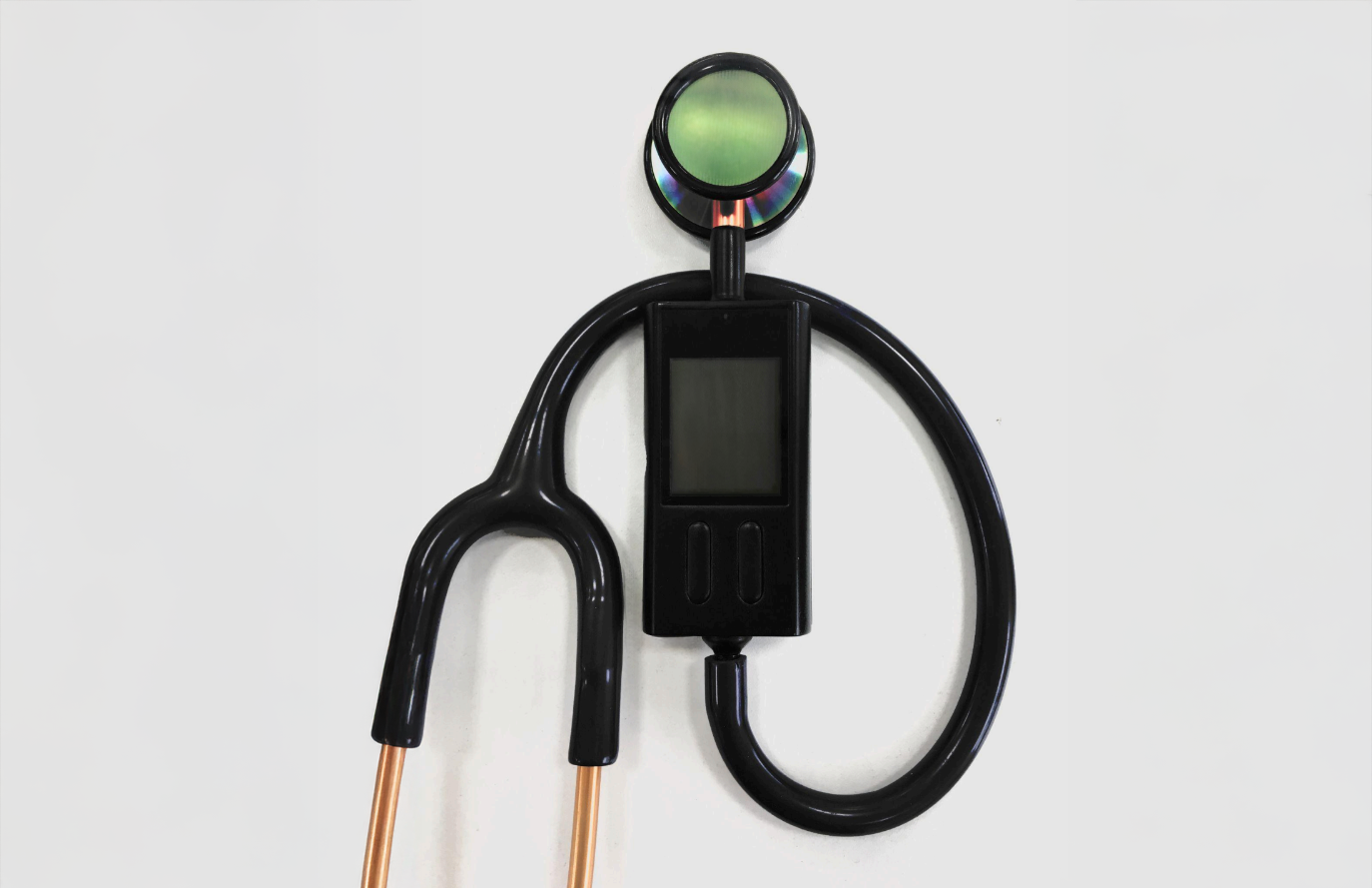How AI is Changing Healthtech: AI-powered Stethoscope System

Did you know that the healthtech market size now accounts for over 500 billion dollars? The rise is massive indeed. And it’s projected to grow even more rapidly with AI.
Thanks to the artificial intelligence tools, patients can now count on better healthcare services. In the meantime, medical professionals feel the relief of the reduced paperwork and more precise diagnoses as they employ new AI and IoT products.
And there is good news for healthtech startups, too—venture capitalists are allocating 38% of new investment dollars in healthcare to AI-enabled and IoT-enabled technology.
What are the key trends in healthtech in 2024? How to ensure your AI healthtech product fits the global market? In this piece, we will share the insights on the key trends in digital health, as well as uncover the results of our flagship project—AI-powered IoT stethoscope system for healthcare professionals.
6 Trends in Healthtech to Keep an Eye on
Healthtech is undergoing rapid change as the technologies evolve. Even 15 years ago, we couldn’t think about beating diabetes or other similar diseases. Now, though the disease is still prevalent, patients are gaining more control over the state of their health.
Let’s look at some major trends in digital health:
- Virtual care is on the rise. After the pandemic, most healthcare professionals have adopted telemedicine to care for their patients no matter where they are. Now, you can get your prescription in a matter of a click.
- Data comes first. Enriched data sets help providers make real-time healthcare decisions. The more data—the better.
- Data ownership talks. Cybersecurity plays a major role here. It’s increasingly important how the data is acquired, stored, and used. Healthtech startups should pay attention to protecting patient’s valuable information.
- AI is everywhere. It helps healthcare providers document their findings and advise patients. This relieves the burden of paperwork, allowing specialists to focus on their core tasks.
- Wearable devices popularity. Wearables like smartwatches and fitness trackers help monitor chronic conditions—diabetes, heart disease—and overall health.
- Accessibility matters. It’s crucial for digital health technologies providers to make their solutions widely accessible. As a creator, you should ensure your tool benefits people all over the world.
The points above add up to the worldwide trend for health hedonism, uncovered by the Backslash in 2024. The authors say that the once-sterile medical industry is becoming more open as patients perceive healthcare as an innate part of their wellness. They also suggest healthtech startups should add some gamification to their products, as well as introduce affordable forms of self-care for the masses.
Key Challenges for Healthcare Ardas Solves
For almost 20 years, we have been developing advanced healthtech solutions to help medical professionals in their daily routines. Here are some key challenges we solve:

Learn more...
Find out about Pharmacy Management Software Development in our article.
- Reduced paperwork. We develop custom healthcare solutions for clinics and hospitals. These solutions significantly reduce paperwork and free up time to provide top-notch personalized services.
- Healthcare compliance management. Our team provides professional support on regulatory compliances such as HIPAA, local requirements, etc., to maintain safe and effective healthcare systems.
- Inefficient patient management. We develop solutions following the precise needs and requirements of your business.
- Better patient service. Our IoT healthcare solutions facilitate service optimization and personalization to deliver better services quickly and efficiently.
Our case: Ardas’ AI-powered IoT Stethoscope System for Healthcare Professionals
We aim to focus on impact projects, and luckily had a chance to do so. In 2021, our team embarked on a challenge to create an AI-powered IoT-enabled stethoscope system that would benefit both patients and healthcare specialists. Here is the story behind the project:
About IoT Healthcare Device

The IoT Stethoscope contains a special AI model. It is the neural network algorithm that uses a data set to recognize the auscultation sound. If the AI option is turned on in device settings (it is turned on by default), the user can see the recognition result on the screen after stopping the auscultation. This result will also be voiced on a headset.
The IoT integration allows the Smart Stethoscope to interact with mobile applications and the cloud, which adds more features to the system. WiFi is used as a communication channel. The device works as a WiFi access point.
Our Role
Our role was to develop a comprehensive software solution and AI model and ensure their seamless integration with a stethoscope device created by an external team. This included a mobile app for data synchronization and AI analysis, a web app for secure data management, and a real-time AI model for sound analysis. Ardas provided a cloud-based backend for secure data storage and high system performance. Through close collaboration with the device team, we delivered a reliable, secure IoT healthcare solution to improve diagnostic accuracy and streamline patient care for healthcare providers.
This AI stethoscope system aims to become a comprehensive healthtech solution that facilitates collaborative care focused on patient health and operational efficiency.
Let's Chat Now
We can help you to build AI software from scratch or re-architect existing software according to the latest technologies.
The Goal
The client aimed to create an AI-powered IoT-enabled stethoscope system that modernizes patient diagnostics. This telehealth solution would leverage AI to analyze heart and lung sounds, supporting early detection of potential diseases and enhancing patient care.
Team’s Challenge
For project’s success, we navigated a couple of critical challenges:
- Regulatory compliance. The system needed to be adhered to FDA Class II, HIPAA, and GDPR standards; healthcare data interoperability was ensured through HL7 FHIR.
- Data security. Ardas offered to implement end-to-end encryption and secure data storage. However, the client chose a different approach—anonymizing patient data. Instead of storing full names, we only store a patient ID, which the doctor separately records in their medical log.
- Performance. The project achieved rapid response times and 99.9% uptime, as well as ensured scalability to support 10,000 concurrent users.
- Adaptability. Our team supported diverse healthcare environments, including offline functionality for areas with limited connectivity.
- Noise filtering and model refinement. The project's AI model relies on diverse, high-quality data. A key challenge we faced was that the device records constantly modified sounds (such as heartbeats overlaid with external noise). We are training the system to filter out extraneous sounds and provide accurate diagnoses, even with a heterogeneous dataset. That’s why the machine learning model is constantly being refined to meet the target accuracy rate of over 85%.
The Team Behind the Healthcare Solution
Ardas’ journey with this project started in 2021, leading to product development in 2022, followed by a two-year pause. Work resumed in the summer of 2024 to allow time for FDA certification and to assemble a skilled hardware team with specialized expertise. Our team consisted of backend, frontend, mobile, DevOps, UI/UX, QA, data scientists, business analysts, and project managers. They collaborated closely with external hardware experts to build a fully integrated, end-to-end solution.
Product Key Features:

- User authentication. Provides secure login, registration, and password management features, ensuring only authorized healthcare professionals can access sensitive patient data.
- Sound capture and recording. It enables the recording of heart and lung sounds using the stethoscope device, and it can measure and display the heartbeat rate for real-time monitoring.
- AI-powered sound analysis. Analyzes recorded sounds on the device using AI and machine learning algorithms, categorizing them as normal, murmurs, crackles, or wheezes for more precise diagnostics.
- Patient record management. Allows healthcare providers to create, update, and manage patient records, offering a structured way to keep track of patient history and health data over time.
- Data synchronization. Ensures seamless data synchronization between the mobile app, web app, and cloud backend, enabling healthcare professionals to access up-to-date information across all devices.
- Data review interface. It provides intuitive, user-friendly interfaces on mobile and web platforms, allowing healthcare professionals to review and manage patient data easily.
- Report generation and analytics. Generates detailed reports and analytics based on collected sound data and patient information, supporting informed decision-making and streamlined patient care.
Conclusion
AI is revolutionizing healthtech, improving patient care and diagnostics. Our AI-powered IoT stethoscope system exemplifies this transformation, offering real-time sound analysis for better early detection and personalized care. With a focus on security, compliance, and scalability, we help healthcare professionals deliver more efficient services. For Ardas, the key idea remains to continue delivering AI-powered solutions that bring real-world impact.
